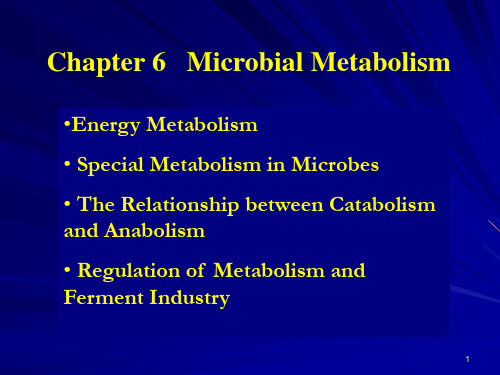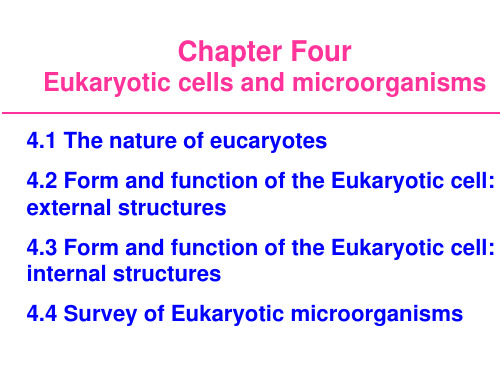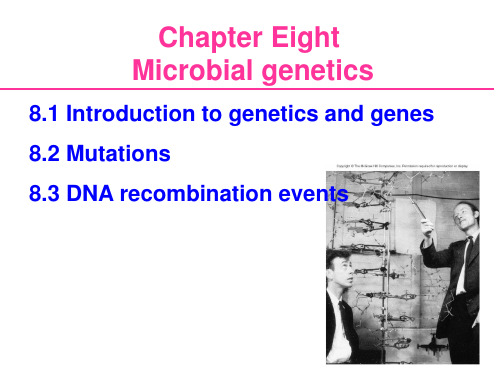微生物学英文6PPT课件
微生物学英文课件

HyServe
Compact Dry SL (Salmonella)
• Salmonella form green colonies/aereas and change the medium to yellow
-> Salmonella decarboxylase alkalizes the medium and changes the medium from purple to yellow
3M Petrifilm • flexible film -> not stackable
-> elaborate closing procedure
-> 3-dimensional growth impos • different technology -> squeezer causes problems with air bubbles
HyServe
Benefits compared to the 3M Petrifilm concept
Compact Dry • solid cartridge -> unlimited stackable -> safe, closed cover -> 3-dimensional growth of molds • similar to petridish -> higher acceptance for conventional microbiology customer -> colony picking is possible
-> risk of contamination during inoculation procedure
HyServe
微生物英文课件-growth-A

• essential component of some vitamins and the amino acids: methionine (蛋氨酸)& cysteine (半胱
氨酸)
• contributes to stability of proteins by forming disulfide bonds
6.1 Microbial nutrition
6.1.1. Nutrient requirements
Nutrients are substances used in biosynthesis and energy production and therefore are required for microbial growth.
Hydrogen
• major element in all compounds & several inorganic ones (water, salts & gases)
• gases are produced & used by microbes • roles of hydrogen
• 70% water • 97% the dry cell weight is composed of organic compounds
微生物学-第六章-微生物的代谢课件

G
6-磷酸-果糖
特征性酶 磷酸己糖酮解酶
4-磷酸-赤藓糖 + 乙酰磷酸
6-磷酸-果糖
5-磷酸-木酮糖 ,5-磷酸-核糖
戊糖酮解酶
乙酸
3--磷酸甘油醛+ 乙酰磷酸
乳酸
乙酸
1 G 乳酸 + 1.5乙酸 + 2.5 ATP
三、发酵(fermentantion)
1、定义
广义:利用微生物生产有用代谢一种生产方式。 狭义:厌氧条件下,以自身内部某些中间代谢
氧化氮还原酶
反硝化意义:
1)使土壤中的氮(硝酸盐NO3-)还原成氮气而消失,降低土壤的肥力;
2)反硝化作用在氮素循环中起重要作用。
硫酸盐呼吸(硫酸盐还原)
——厌氧时,SO42- 、SO32-、S2O32- 等为末端电 子受体的呼吸过程。
特点:
a、严格厌氧; b、大多为古细菌 c、极大多专性化能异氧型,少数混合型; d、最终产物为H2S;
用所需的硝酸盐还原酶A亚硝酸还原酶等 c 兼性厌氧 细菌:铜绿假单胞、地衣芽孢杆菌等。
硝酸盐作用
同化性硝酸盐作用:
NO3- NH3 - N R - NH2 异化性硝酸盐作用:
无氧条件下,利用NO3-为最终氢受体
NO3- NO2 NO N2O N2
硝酸盐还原酶
亚硝酸还原酶
氧化亚氮还原酶
a、a1、a2、a4、b、b1、c、c1、c4、c5、d、o等; 末端氧化酶:
cyt a1、a2、a3、d、o,H2O2酶、过氧化物酶;呼吸链组分多变 存在分支呼吸链:
细菌的电子传递链更短并P/O比更低,在电子传递链的几个位置进入链和 通过几个位置的末端氧化酶而离开链。 E.coli (缺氧) CoQ cyt.b556 cyt.o
微生物专业英语

微生物专业英语GE GROUP system office room 【GEIHUA16H-GEIHUA GEIHUA8Q8-微生物学 microbiology病毒学 virology噬菌体学 bacteriophagology细菌学 bacteriology鉴定细菌学 determinative bacteriology 系统细菌学 systematic bacteriology真菌学 mycology原生生物学 protistology原生动物学 protozoology普通微生物学 general microbiology微生物分类学 microbial taxonomy微生物生理学 microbial physiology微生物生物化学 microbial biochemistry 微生物遗传学 microbial genetics微生物生态学 microbial ecology古微生物学 pale microbiology土壤微生物学 soil microbiology水生微生物学 aquatic microbiology海洋微生物学 marine microbiology悉生生物学 gnotobiology医学微生物学 medical microbiology兽医微生物学 veterinary microbiology 农业微生物学 agricultural microbiology 工业微生物学 industrial microbiology 石油微生物学 petroleum microbiology食品微生物学 food microbiology乳品微生物学 diary microbiology瘤胃微生物学 rumen microbiology诊断微生物学 diagnostic microbiology 病原学 etiology国际微生物学会联合会 International Union of Microbiological Societies, IUMS中国微生物学会 Chinese Society for Microbiology, CSM世界培养物保藏协会 World Federation for Culture Collection, WFCC中国微生物菌种保藏管理委员会 China Committee for Culture Collection of Microorganisms, CCCCM美国模式培养物保藏所 American Type Culture Collection, ATCC自然发生说,无生源说 spontaneous generation, abiogenesis原界 urkingdom始祖生物 progenote古始生物界 archetista古细菌 archaebacteria原生生物 protista原生动物 protozoan原生植物 protophyte真核生物 eukaryote原核生物 prokaryote裂殖植物 schizophyte微生物 microorganism数值分类法 numerical taxonomy 模式目 type order模式科 type family模式属 type genus模式种 type species模式株 type strain真菌 fungi捕食真菌 predacious fungi虫道真菌 ambrosia fungi地下真菌 hypogeal fungi虫生真菌 entomogenous fungi 菌根真菌 mycorrhizal fungi木腐菌 wood-decay fungi霉菌 mold, mould半知菌 imperfect fungi子囊菌 ascomycetes粘菌 slime mold, slime mould壶菌 chytrid卵菌 oomycetes接合菌 zygomycetes担子菌 basidiomycetes核菌 pyrenomycetes盘菌 cup fungi块菌 truffles锈菌 rust fungi蘑菇 mushrooms毒蘑菇 poisonous mushroom酵母菌 yeast无孢子酵母菌 asporogenous yeasts有孢子酵母菌 sporogenous yeasts 黑粉菌 smut fungi双态性真菌 dimorphic fungi毛外癣菌 ectothrix毛内癣菌 endothrix完全真菌 perfect fungi黑粉病 smut disease锈病 rust disease菌丝 hypha菌髓 trama假菌丝体 pseudomycelium气生菌丝体 aerial mycelium基内菌丝体 substrate mycelium 球拍状菌丝体 racquet mycelium 结节状菌丝 nodular mycelium梳状菌丝 pectinafe mycelium螺旋菌丝 spiral mycelium匍匐菌丝 stolon次生菌丝体 secondary mycelium有隔菌丝 septate hypha无隔菌丝 nonseptate hypha生殖菌丝体 reproductive mycelium 营养菌丝体 vegetative mycelium不育菌丝体 sterile mycelium菌丝体 mycelium黄癣菌丝 favic chandelier mycelium 产囊丝 ascogenous hypha产囊体 ascogonium原植体 thallus粘菌体 aethalium合胞体 syncytium虫菌体 hyphal body盾状体 clypeus子实体 fruiting body 产孢体 gleba子实层体 hymenophore 子实层 hymenium子实下层 subhymenium 菌丝层 subiculum菌丝段 hyphal fragment 菌丝束 coremium菌丝索 funiculus菌核 sclerotium器菌核 pycnosclerotium 菌环 annulus菌裙 indusium菌盖 pileus顶体 apicle藏卵器 oogonium雄器 antheridium[锈菌]性孢子器 pycnium锈子器 aecium精子器 spermogonium囊状体 cystidium粉孢子梗 oidiophore小梗 sterigma接合孢子柄 zygosporophore 孢囊柄 sporangiophore配囊柄 suspensor孢子梗 sporophore分生孢子梗 conidiophore 雄器柄 androphore帚状枝 penicillus瓶梗 phialide梗基 metulae芽孔 germ pore芽管 germ tube芽缝 germ slit孢丝 capillitium周丝 periphysis类周丝 periphysoid侧丝 paraphysis拟侧丝 pseudoparaphysis类侧丝 paraphysoid[孢子]外壁 exosporium外生菌根 ectomycorrhiza内生菌根 endomycorrhiza内外生菌根 ectendomycorrhiza泡囊丛枝菌根 vesicular-arbuscular mycorrhiza 刺突 spike弹丝 elater刚毛 seta微体 microbody泡囊 vesicle隔膜 septum假隔膜 pseudoseptum分生孢子盘 acervulus分生孢子座 sporodochium 精子团 spermatium囊基膜 hypothallus囊层基 hypothecium囊层被 epithecium囊间丝 hamathecium囊托 apophysis囊领 collarette囊轴 columella孔口 ostiole菌托 volva孢子角 cirrus孢子球 spore ball孢子印 spore print聚簇 cluster[菌丝]融合 anastomosis [孢子]切落 abjunction [孢子]缢断 abstriction 多态[现象] polymorphism 缢缩[作用] constriction 粉孢子 oidium孢子 spore掷孢子 ballistospore厚壁孢子 chlamydospore 环痕孢子 annellospore卷旋孢子 helicospore腊肠形孢子 allantospore 孔出孢子 porospore星形孢子 staurospore线形孢子 scolecospore砖格孢子 dictyospore侧生孢子 aleuriospore芽生孢子 blastospore瓶梗孢子 phialospore无梗孢子 thallospore分生孢子 conidium大分生孢子 macroconidium 小分生孢子 microconidium 节分生孢子 arthroconidium 芽分生孢子 blastoconidium无隔孢子 amerospore双胞孢子 didymospore多隔孢子 phragmospore休眠孢子 hypnospore顶生孢子 acrospore顶生厚壁孢子 fuseau内分生孢子 endoconidium担孢子 basidiospore双孢担孢子 dispore同形孢子 isospore柄生孢子 stylospore[锈菌]性孢子 pycniospore产雄器孢子 androspore锈孢子 aeciospore夏孢子 urediniospore, aeciospore四分孢子 tetraspore粘孢子 myxospore多核孢子 coenospore孢囊孢子 sporangiospore子囊孢子 ascospore多核细胞 coenocyte分生孢子果 conidiocarp分生孢子器 pycnidium孢[子]囊 sporangium柱孢子囊 merosporangium四分孢子囊 tetrasporangium 原孢子囊 prosporangium多核孢子囊 coenosporangium 休眠孢子囊 hypnosporangium 子囊 ascus拟接合孢子 azygospore原囊壁子囊 prototunicate ascus 单囊壁子囊 unitunicate ascus 双囊壁子囊 bitunicate ascus子囊果 ascocarp子囊壳 perithecium闭囊壳 cleistothecium闭囊果 cleistocarp盘状子囊果 discocarp孢囊果 sporangiocarp[接]合子 zygote单性合子 azygote多核合子 coenozygote异形合子 heterozygote合子核 zygotonucleus游动合子 planozygote担子 basidium半担子 hemibasidium隔担子 heterobasidium无隔担子 holobasidium有隔担子 phragmobasidium 内生担子 endobasidium原担子 protobasidium上担子 epibasidium下担子 hypobasidium同担子 homobasidium担子果 basidiocarp担子体 basidiophore配子 gamete原配子 progamete雄配子 androgamete雄核发育 androgenesis同形配子 isogamete异形配子 heterogamete游动配子 zoogamete多核配子 coenogamete配子囊 gametangium配子母细胞 gametocyte同形配子囊 isogametangium 原配子囊 progametangium 小孢子囊 sporangiole微包囊 microcyst足细胞 foot cell脚胞 foot cell固着器 holdfast附着枝 hyphopodium吸盘 sucker锁状细胞 clamp cell锁状联合 clamp connection 偶核细胞 zeugite卵球 oosphere卵质 ooplasm孢原质 sporoplasm卵配子 oogamete卵孢子 oospore球状胞 sphaerocyst子囊腔 locule子囊盘 apothecium子囊座 ascostroma缝裂壳 hysterothecium下子座 hypostroma包被 peridium子座 stroma壳心 centrum拟包被 pseudoperidium无融合生殖 apomixis同宗配合 homothallism准性生殖 parasexuality异宗配合 heterothallism同配生殖 isogamy异配生殖 heterogamy无配生殖 apogamy配囊交配 gametangial copulation 交配型 mating type全型 holomorph夏孢子期 uredostage冬孢子堆 teleutosorus, telium 夏孢子堆 uredinium子囊孢子形成 ascosporulation孢子形成 sporulation细菌 bacteria薄壁[细]菌类 gracilicutes硬壁[细]菌类 fermicutes疵壁[细]菌类 mendosicutes无壁[细]菌类 tenericutes柔膜细菌 mollicutes真细菌 eubacteria暗细菌 scotobacteria无氧光细菌 anoxyphotobacteria 生氧光细菌 oxyphotobacteria 放线菌 actinomycetes螺[旋]菌 spirilla粘细菌 slime bacteria鞘细菌 sheathed bacteria柄细菌 caulobacteria弧菌 vibrio根瘤细菌 root nodule bacteria硫酸盐还原菌 sulfate reducting bacteria硫细菌 sulfur bacteria铁细菌 iron bacteria紫色无硫细菌 purple nonsulfur bacteria产甲烷菌 methanogen硝化细菌 nitrobacteria反硝化细菌 denitrifying bacteria固氮细菌 nitrogen fixing bacteria甲基营养菌 methylotrophic bacteria产乙酸菌 acetogen同型[产]乙酸细菌 homoacetogenic bacteria光合作用细菌 photosynthetic bacteria产氢产乙酸细菌 hydrogen-producing acetogenic bacteria 同型发酵乳酸菌 homofermentative lactic bacteria异型发酵乳酸菌 heterofermentative lactic bacteria 产氢菌 hydrogenogens产气菌 aerogen不产气菌 anaerogen发光细菌 luminous bacteria产色细菌 chromogenic bacteria化能异养菌 chemoheterotrophic bacteria化能自养菌 chemoautotrophic bacteria光能异养菌 photoheterotrophic bacteria光能自养菌 photoautotrophic bacteria化能有机营养菌 chemoorganotrophic bacteria化能无机营养菌 chemolithotrophic bacteria光能有机营养菌 photoorganotrophic bacteria光能无机营养菌 photolithotrophic bacteria有机营养菌 organotrophic bacteria无机营养菌 lithotrophic bacteria贫[营]养细菌 oligotrophic bacteria一氧化碳营养菌 carboxydotrophic bacteria 自养菌 autotrophic bacteria异养菌 heterotrophic bacteria光养菌 phototrophic bacteria需氧菌 aerobe微需氧菌 microaerobe耐氧菌 aerotorelant bacteria厌氧菌 anaerobe兼性厌氧菌 facultative anaerobe专性厌氧菌 obligate anaerobe溶原性细菌 lysogenic bacteria腐生菌 saprophytic bacteria苛求菌 fastidious microorganism极端细菌 extreme bacteria嗜压菌 barophilic bacteria嗜盐菌 halophilic bacteria嗜铁菌 siderophilic bacteria嗜高渗细菌 osmophilic bacteria微嗜氮菌 oligonitrophilic bacteria 嗜冷[细]菌 psychrophilic bacteria 嗜酸菌 acidophilic bacteria嗜硫菌 thiophilic bacteria中温菌 mesophilic bacteria耐热细菌 thermophilric bacteria氢营养菌 hydrogenotrophic bacteria 肠道细菌 intestinal bacteria类菌体 bacteroid细菌小体 bacteriosome微生子 gonidium蓝细菌 cyanobacteria[蓝细菌]连锁体 hormogonium类囊体 thylakoid藻胆蛋白体 phycobilisome静息孢子 akinete滑行 gliding异形[囊]胞 heterocyst化学型 chemotype化学变型 chemovar血清型 serotype血清变型 serovar致病型 pathotype致病变型 pathovar生物型 biotype生物变型 biovar形态型 morphotype形态变型 morphovar革兰氏阳性菌 Gram-positive bacteria革兰氏阴性菌 Gram-negative bacteria 球菌 coccus双球菌 diplococcus四联球菌 tetrads八叠球菌 sarcina球杆菌 coccobacillus杆菌 rod双杆菌 diplobacillus棒状菌 corynebacteria[细菌]毛状体 trichome单鞭毛菌 monotricha周[鞭]毛菌 peritricha丛[鞭]毛菌 lophotricha两端单[鞭]毛菌 amphitrichate单端丛[鞭]毛菌 cephalotricha滑行细菌 gliding bacteria细菌L-型 L-form of bacterium菌落 colony酵母型菌落 yeast type colony类酵母型菌落 yeast like colony次生菌落 secondary colony粗糙型菌落 rough colony光滑型菌落 smooth colony丝状型菌落 filamentous type colony 子菌落 daughter colony深层菌落 deep colony粘液型菌落 mucoid colony巨大菌落 giant colony侏儒型菌落 dwarf colony菌苔 lawn菌胶团 zoogloea菌膜 pellicle[菌]醭 mycoderm, pellicle群游现象 swarming菌柄 stipe[菌体]附器 appendage鞭毛 flagellum周质鞭毛 periplasmic flagella 轴丝 axial filament菌毛 pilus性丝 sex pilus外生孢子 exospore内生孢子 endospore芽孢 spore芽孢形成 sporulation终端芽孢 terminal spore近端芽孢 subterminal spore中生芽孢 central spore前芽孢 forespore[芽孢]皮层 cortex芽孢外膜 exitine芽孢内膜 intine外壁 exine伴胞晶体 parasporal crystal 菌蜕 ghost鞘 sheath荚膜 capsule粘液层 slime layer微荚膜 microcapsule壁膜间隙 periplasmic space 原生质体 protoplast原生质球 spheroplast气泡 gas vacuole甲烷粒体 methanochondria间体 mesosome载色体 chromatophore鞭毛基体 flagellar basal body异染质 volutin异染粒 matachromatic granules致死颗粒 killer particle紫膜 purple membrane噬菌体 bacteriophage无囊盖类 inoperculatae超显微微生物 ultramicroscopic organism 真菌噬菌体 mycophage噬藻体 phycophage烈性噬菌体 virulent phage温和噬菌体 temperate phage前原噬菌体 preprophage原噬菌体 prophage隐性前噬菌体 cryptic prophage营养期噬菌体 vegetative phage载体噬菌体 carrier phageλ噬菌体 lambda particles phage [可]诱导噬菌体 inducible phage 同源免疫噬菌体 homoimmune phage 噬菌体分型 bacteriophage typing 噬菌体型 phagetype噬菌体变型 phagevar噬斑 plaque[噬菌体]聚合头部 polyhead[噬菌体]聚合尾鞘 polysheath[噬菌体]伞毛 fimbrium[噬菌体]颈须 whisker[噬菌体]先导蛋白 pilot protein [噬菌体]尾丝抗原 fiber antigen[噬菌体]顶体 apex[噬菌体]基片插孔 base-plate hub [噬菌体]基片丝 base-plate fibril [噬菌体]基片楔突 base-plate wedge [噬菌体]串联体 concatemer[噬菌体]颈部 collar[噬菌体]顶部壳粒 apical capsomere [噬菌体]尾丝 tail fiber[噬菌体]畸形体 monster[噬菌体]颈圈 connector[噬菌体]髓部 core[噬菌体]头部 head[噬菌体]尾部 tail[噬菌体]尾管 tail tube[噬菌体]尾鞘 tail sheath类病毒 viroid病毒 virus真病毒 euvirus亚病毒 subvirus原病毒 provirus拟病毒 virusoid卫星病毒 satellite virus假型病毒 pseudotype virus慢病毒 slow virus辅助病毒 helper virus过客病毒 passenger virus多分体病毒 multicomponent virus昆虫痘病毒 entomopox virus, EPV颗粒体症病毒 granulosis virus, GV多角体病毒 polyhedrosis virus核型多角体病毒 nuclear polyhedrosis virus, NPV质型多角体病毒 cytoplasmic polyhedrosis virus,CPV多粒包埋型病毒 multiple embedded virus 单粒包埋型病毒 singly embedded virus 伴随病毒 associated virus浓核病毒 densovirus,DNV内源病毒 endogenous virus潜伏病毒 latent virus肠道病毒 enterovirus艾柯病毒 ECHO virus虫媒病毒 arbovirus腺病毒 adenovirus腺伴随病毒 adeno associated virus真菌病毒 mycovirus肿瘤病毒 oncovirus逆[转]录病毒 retro virus坏死病毒 necrosis virus虹彩病毒 irido virus泛嗜性病毒 pantropic virus毒株 strain原[生小]体 elementary body包含体 inclusion body顾氏小体 Guarnieri's bodies内氏小体 Negri's body病毒[粒]体 virion裸露病毒[粒]体 naked virion假病毒体 pseudovirion立体对称 cubical symmetry二十面体对称 icosahedral symmetry 螺旋对称 helical symmetry[病毒]五邻体 pentomer,pentons [病毒]六邻体 hexonmer,hexons复合对称 complex symmetry包膜突起 peplomerbody包膜 envelope, peplos蛋白质包膜 protein envelope[病毒]包膜抗原 envelope antigen [病毒]壳体 capsid[病毒]壳粒 capsomer, capsomere二十面[体]壳体 icosahedron capsid 核心 core核壳 nucleocapsid病毒原质体 viroplasma病毒束 virus bundle多角体 polyhedron多角体蛋白 polyhedrin颗粒体 granule颗粒体蛋白 granulin类核 nucleoid内含颗粒 inclusion granuleX体 X-body[病毒]早期蛋白 early protein[病毒]晚期蛋白 late protein负链 negative strand正链 positive strand复制子 replicon病毒发生基质 virogenic stroma衣原体 chlamydia[衣原体]始体 initial body立克次氏体 rickettsia假肽聚糖 pseudopeptidoglycan肽聚糖 peptidoglycan磷壁酸 teichoic acid胞壁酸 muramic acid2,6-吡啶二羧酸 dipicolinic acid, DPA 脂多糖类 lipopolysaccharides多糖包被 glycocalyx鞭毛蛋白 flagellin菌毛蛋白 pilin杀白细胞素 leucocidin豆血红蛋白 leghaemoglobin藻胆蛋白 phycobiliprotein藻青蛋白 phycocyanin藻红蛋白 phycoerythrin藻青素 cyanophycin藻蓝素 algocyan, leucocyan藻胆素 phycobilin藻红[胆]素 phycoerythrobilin 藻蓝胆素 phycocyanobilin藻青素颗粒 cyanophycin granule 别藻蓝素 allophycocyanin类葫萝卜素 carotenoids细菌淀粉粒 granulose聚β羟基丁酸盐 poly-β-hydroxy butyrate葡萄球菌A蛋白 staphylococcal protein A, SPA纯化蛋白衍生物 purified protein derivative, PPD [葡萄球菌]凝固酶 staphylocoagulaseβ[细胞]溶素β-lysinα淀粉酶α-amylase通透酶 permease胞内酶 intracellular enzyme胞外酶 extracellular enzyme果胶酶 pectinase逆[转]录酶 reverse transcriptase凝固酶 coagulase受体破坏酶 receptor destroying enzyme, RDE透明质酸酶 hyaluronidase纤维素酶 cellulase链道酶 streptodornase,SD链激酶 streptokinase,SK神经氨酸酶 neuraminidase青霉素酶 penicillinase溶菌酶 lysozyme[细菌]紫膜质 bacteriorhodopsin菌紫素 bacteriopurpurin[细]菌[叶]绿素 bacteriochlorophyll 自溶素 autolysin亲菌素 bacteriotropin攻击素 aggressin抑殖素 ablastin粘附素 adhesin菌红素 bacterioerythrin灵菌毒素 prodigiosus toxin细菌素 bacteriocin麻风菌素 lepromin葡萄球菌素 staphylococcin伞菌氨酸 agarfitine苏云金菌素 thuricin肠球菌素 enterococcin布氏菌素 brucellin大肠菌素 colicin, colicine丁香假单胞菌素 syringacin黄色粘球菌素 xanthacin链球菌素 streptocin流产菌素 abortin绿脓[菌]素 pyocyanin红假单胞菌素 rhodopseudomonacin 绿脓菌荧光素 pyofluorescein白喉毒素 diphtheria toxin杯伞素 clitocybine白细胞溶素 leucolysin表皮溶解毒素 epidermolytic toxin 产气荚膜梭菌素 perfringocin肠毒素 enterotoxin毒蝇碱 muscarine肺炎球菌毒素 pneumotoxin鬼笔[毒]环肽 phalloidin根霉蝶呤 rhizopterin肺炎[链]球菌溶血素 pneumolysin 黑粉菌酸 ustilagic acid分枝菌酸 mycolic acid齿孔酸 eburicoic acid根霉促进素 rhizopin蘑菇素 agaricin蘑菇酸 agaricinic acid红斑毒素 erythrogenic toxin黄曲霉毒素 aflatoxin菌丝酰胺 mycelianamide绿脓杆菌溶血素 pyocyanolysin葡萄球菌溶血毒素 staphylolysin 真菌毒素 mycotoxin曲霉毒素 aspertoxin赭曲毒素 ochratoxin曲酸 kojic acid破伤风[菌]痉挛毒素 tetanospasmin 溶葡萄球菌素 lysostaphin破伤风[菌]溶血素 tetanolysin溶纤维蛋白溶酶 fibrinolysin溶血素 hemolysin鼠疫菌素 pesticin神经毒素 neurotoxin杀[细]菌素 bactericidin外毒素 exotoxin内毒素 endotoxin细菌毒素 bacteriotoxin血凝素 hemagglutinin杂色曲霉素A versicolorin A柄曲霉素 sterigmatocystin毒植物素 phytotoxin真菌醇 mykol链球菌溶血素 streptolysin剥脱性毒素 exfoliative toxin 细菌荧光素 bacteriofluorescein [放线菌]土臭味素 geosmins土壤杆菌素 agrobacteriocin产甲烷[作用] methanogenesis生物转化 bioconversion生长因子 growth factor420 因子 factor 420V 因子 V factorX 因子 X factor辅酶 M coenzyme M微量营养 micronutrient特需营养要求型 idiotroph微[量]动[力]作用 oligodynamic action 抗代谢物 antimetabolites索状因子 cord factor异株克生物质 allelopathic substances 光能无机营养 photolithotrophy光能有机营养 photoorganotrophy化能无机营养 chemolithotrophy化能有机营养 chemoorganotrophy光营养 phototrophy兼性营养 amphitrophy腐生营养 saprophytic nutrition 甲基营养 methylotrophy化能营养 chemotrophy自养 autotrophy光能自养 photoautotrophy化能自养 chemoautotrophy半自养 mesotrophy异养 heterotrophy氮平衡 nitrogen balance碳平衡 carbon balance磷平衡 phosphorus balance同化作用 assimilation异化作用 dissimilation氨化作用 ammonification硝化作用 nitrification反硝化作用 denitrification固氮作用 nitrogen fixation非共生固氮作用 asymbiotic nitrogen fixation 光同化作用 photo-assimilation巴氏效应 Pasteur effect葡萄糖效应 glucose effect种间分子氢转移 interspecies H transfer发酵 fermentation发酵[能]力 fermentation capacity可发酵性 fermentability同型发酵 homofermentation异型发酵 heterofermentation厌氧消化 anaerobic digestion厌氧呼吸 anaerobic respiration厌氧生活 anaerobiosis需氧呼吸 aerobic respiration需氧生活 aerobiosis反馈抑制 feed back inhibition内源变量 endogenenous variable异养潜能 heterotrophic potential溶菌丝作用 hypholytic action溶菌作用 bacteriolysis费氏[溶菌]现象 Pfeiffer's phenomenon 自溶[现象] autolysis裂殖 schizogenesis芽殖 budding二分分裂 binary fission不等分裂 unequal fission断裂 fragmentation复分裂 multiple fission隐蔽期 eclipse period比生长速率 specific growth rate同步生长 synchronous growth。
华中农业大学微生物英文版课件

目录
CONTENTS
• Introduction • Types of Microorganisms • Microbial Metabolism • Microbial Life Processes • Microbial Ecology • Microbial Pathogenesis and Disease
04 Microbial Life Processes
Cell Structure and Function
Cell membrane
Composition, function, and transport processes across the membrane
Cell wall
Structure, function, and role in maintaining cell shape and protecting the cell
Fungi play important roles in composition, nutrient cycling, and symbolic relationships with plants and animals
Some fungi are editable and have culinary uses, while others can cause diseases in plants and animals
Cultivation and Respiration
Microorganisms can be cultured in different environments, such as on solid surfaces or in liquid media The choice of cultivation environment depends on the type of microbiology and the desired outcome of the experience or study
e6 微生物学南京师范大学 英文版PowerPointPPT课件

6
1)Embden-Meyerhof-Parnas Pathway (EMP)
(Glycolysis, Hexose Diphosphate Pathway)
Ten steps
glucose
pyruvate
with O2 :connecte EMP pathway with TCA pathway; without O2:reduce some metabolism product, only energyyielding process.
6 gplhuocsopshea6te-psh+os6pChOat2e+s1+21N2ANDAPDHP+++132HH2+O+P→i 5 glucose 6-
9
3) Entner-Doudoroff Pathway (KDPG Pathway)
1952, Entner-Doudoroff :Pseudomonas saccharophila
Operates with glycolysis
8
fructose 6-phosphates:
be converted to glucose 6-phosphates ,be returned to Pentose Phosphate Pathway
glyceraldehyde 3-phosphate :
1
An Overview metabolism
metabolism:
the sum total of all chemical reactions occurring in the cell
微生物英文课件-eucaryotes

• Rough endoplasmic reticulum (RER)– originates from the outer membrane of the nuclear envelop & extends in a continuous network through cytoplasm; rough due to ribosomes, proteins are synthesized & shunted into the ER for packaging & transport. First step in secretory pathway.
)
4.2.4. The cell membrane
- typical bilayer of phospholipids and proteins
- Sterols (固醇) confer stability - serve as selectively permeable barriers in transport; involved in cell-cell recognition, endo- and exocytosis and adhesion to surface; transport system is located in membrane
-Eukaryotic cells also contain membrane-bound organelles that account for 60-80% of their volume
•The most obvious difference between Eukaryotic cells and procaryotic cells is in their use of membranes.
临床微生物真菌学英文课件PPT讲义精

Microorganisms can be multiple by binary session, padding, or other methods, depending on the specifications
Pathogenesis
Coexistence and competition
Diagnosis: Identification of the causative agent of a disease is critical for accurate diagnosis and treatment Microbiological tests can identify the presence of microorganisms in clinical samples, such as blood, urine, and issue biopsy specifications
Enzyme lay (ELISA)
A technique that uses antibiotics linked to an enzyme to detect microbial antibodies in serum or other body fluids It is widely used in clinical microbiology and mycology for the diagnosis of various infections
微生物学【英文版】(全套课件499P)

Concepts
Microorganisms are responsible for many of the changes observed in organic and inorganic matter (e.g., fermentation and the carbon, nitrogen and sulfur cycles that occurred in nature.
Microbiology is a large discipline, which has a
1.1 What is a microbe?
The word microbe (microorganism) is used to describe an organism that is so small that can not be seen without the use of a microscope. Viruses, bacteria, fungi, protozoa and some algae are all included in this category.
Microbial world
Organisms
(living)
Infectious agents (non-living) viruses viroids prions
Prokaryotes (unicellular)
eukaryotes
Eubacteria
Archaea
Algae (unicellular or multicellular)
Chapter 1
Microorganisms and Microbiology
pter outline
1.1 What is a microbe? 1.2 The importance of Microbiology 1.3 Microbes in our lives 1.4 The history of microbiology 1.5 Important events in the development of microbiology
微生物英文课件-gentic A

I. Point mutations
-involve addition, deletion, or substitution of single bases
1. Silent mutations (same-sense mutations) are alterations
Genetics – the study of heredity
1. transmission of biological traits from parent to offspring
2. expression & variation of those traits 3. structure & function of genetic material 4. how this material changes or evolves
Chapter Eight Microbial genetics
8.1 Introduction to genetics and genes 8.2 Mutations 8.3 DNA recombination events
8.1 Introduction to genetics and genes
Levels of genetic study
Levels of structure & function of the genome
• genome – sum total of genetic material of an organism (chromosomes + mitochondria/chloroplasts and/or plasmids)
1 mm; 1,000X longer than cell • Human cell – 46 chromosomes containing 31,000
微生物英文课件-growth-B

3. Aerotolerant anaerobes ignore O2 and grow equally well whether it is present or not (耐氧的厭氧菌)
by causing the formation of thymine dimers in DNA
a. Photoreactivation repairs thymine dimers by direct splitting when the cells are exposed to blue light
2 HSCH2CO2H + "O" → [SCH2CO2H]2 + H2O
Foundations, P202
Brock, P145
Effects of pH
a. Acidophiles嗜酸菌 grow best between pH 0 and 5.5 b. Neutrophiles嗜中性菌 grow best between pH 5.5 and 8.0 c. Alkalinophiles專性嗜堿菌grow best between pH 8.5 and 11.5 d. Extreme alkalinophiles grow best at pH 10.0 or higher
2. Mesophiles – optimum temperature 20o-40oC, most human pathogens(嗜溫菌)
3. Thermophiles – optimum temperature greater than 45oC (耐熱菌)
微生物学课件 第六章 微生物代谢

ATP ADP+P
Fd
(Fe4S4)2
FeMoCo N2
3、CO2同化
①乙醛酸循环 ②丙酮酸羧化支路 ③甘油酸途径:乙醇酸、草酸、甘氨酸底物, 转化为乙醛酸,缩合成羟基丙酮酸半醛,还原成甘 油酸进入EMP途径。
4、糖类的合成
单糖的合成;多糖的合成。
5、氨基酸的合成
氨基化作用;转氨基作用;前体碳骨架合成。
e-
e- Bph
e- QA e- QB e-
Q库
ADP+Pi Cyt.bc1 ATP
逆电子传递 外源H2
NAD(P) NAD(P)H2
P700 e- Cyt.c2
外源电子供体H2S等
非环式光合磷酸化 (non-cyclic photophosphorylation)
1/202 2H+
叶绿素b
e- Ⅱ
③膜透性调节; ④能荷调节; ⑤诱导作用:类似物诱导; ⑥磷酸盐调节。
(1)CO2的固定:空气中的CO2同化成细胞物质的 过程。
①卡尔文循环
②还原性三羧酸循环固定CO2
乙酰CoA
丙酮酸
磷酸烯醇式丙酮酸
草酰乙
酸
琥珀酰CoA
α-酮戊二酸
柠檬酸
乙酸
乙酰CoA
③还原单酸循环
不消耗能量,Fd由H2或NADH2提供电子,由乙酰
CoA 丙酮酸
草酰乙酸
乙酸
2、生物固氮
固氮微生物(nitrogen –fixing organisms, diazotrophs)
代谢调控:利用遗传学方法或其它生物学方法,人 为地改变和控制生物的代谢途径,生产有用物质或进行 有益服务。
二、微生物产能代谢
微生物英文课件-procaryotes-A

1. Stab the cell into semisolid medium in a test tube
2. Observe the cell under the microscope with a hanging drop slide
Flagellar structure
(Brock, P75)
Filament 鞭毛絲 --
long, thin, helical structure composed of proteins
Hook 鉤形鞘-- curved sheath
Basal body 基體-- stack of rings firmly anchored
Peptidoglycan structure
(Brock, P60)
• Back bone: repeating disaccharides of NAM and NAG
• Tetrapeptide (4 alternating D- and L- aa): attached to NAM
• Peptide cross link:
Structure of the cell wall
gram-positive
gram-negative cell
The cell wall helps determine the shape of a bacterium, provides the kind of strong structural support necessary to keep a bacterium from bursting or collapsing because of changes in osmotic pressure
微生物学英文课件The Growth of Microorganisms.ppt

• 50oC and above
• Mesophiles
– moderate temperatures
• near 37oC
• Psychrophiles
– colder temperatures
• below 5oC
© 2004 Wadsworth – Thomson Learning
– Complex mix of microorganisms
– Unique interactions and impact on other microorganisms
© 2004 Wadsworth – Thomson Learning
Continuous culture
• Chemostat
a. Growth can be expressed by the equation
N = No x 2n
where N = number of bacteria at end of growth period No = number of bacteria inoculated at start of growth period
© 2004 Wadsworth – Thomson Learning
Exponential growth
• Binary fission
– each cell becomes two
– each generation doubles the population
– result is exponential growth
exponentially
© 2004 Wadsworth – Thomson Learning
- 1、下载文档前请自行甄别文档内容的完整性,平台不提供额外的编辑、内容补充、找答案等附加服务。
- 2、"仅部分预览"的文档,不可在线预览部分如存在完整性等问题,可反馈申请退款(可完整预览的文档不适用该条件!)。
- 3、如文档侵犯您的权益,请联系客服反馈,我们会尽快为您处理(人工客服工作时间:9:00-18:30)。
Concepts
Microorganisms require about 10 elements in large quantities, in part because they are used to construct carbohydrates, lipids, proteins, and nucleic acids. Several other elements are needed in very small amount and are parts of enzymes and cofactors. All microorganisms can be placed in one of a few nutritional categories on the bases of their requirements for carbon, energy and hydrogen atoms or electrons. Nutrient molecules frequently cannot cross selectively permeable plasma membranes through passive diffusion. They must be transported by one of three major mechanisms involving the use of membrane carrier proteins.
Macronutrients
95% or more of cell dry weight is made up of a few major elements: carbon, oxygen, hydrogen, nitrogen, sulfur, phosphorus, potassium, calcium, magnesium and iron.
The first six ( C, H, O, N, P and S) are components of carbohydrates, lipids, proteins and nucleic acids
ቤተ መጻሕፍቲ ባይዱ
Trace Elements
Microbes require very small amounts of other mineral elements, such as iron, copper, molybdenum, and zinc; these are referred to as trace elements. Most are essential for activity of certain enzymes, usually as cofactors.
Chemoheterotroph (Chenoorganotroph)
Sources of energy, hydrogen/electrons,
Representative microorganisms
and carbon
Light energy, inorganic
Algae, Purple and
Chapter 6
Microbial Nutrition and Metabolism
Chapter outline
6.1 Nutrient requirements 6.2 Nutritional types of microorganisms 6.3 Uptake of nutrients by the cell 6.3 Culture Media 6.4 An Overview of Metabolism 6.5 Fermentation: The Embden-Meyerhof Pathway 6.6 Respiration and Electron Transport 6.7 The Balance Sheet of Aerobic Respiration and Energy Storage 6.8 An Overview of Alternate Modes of Energy Generation 6.9 Biosynthesis of Monomers 6.10 Nitrogen fixation
Growth Factors
(1)Amino acids (2) Purines and pyrimidines, (3) Vitamins Amino acids for protein synthesis Purines and pyrimidines for nucleic acid synthesis. Vitamins are small organic molecules that usually make
3
6.1 Nutrient requirements
Concepts:
Microorganisms require about ten elements in large quantities, because they are used to construct carbohydrates, lipids, proteins, and nucleic acids. Several other elements are needed in very small amounts and are parts of enzymes and cofactors.
up all or part enzyme cofactors, and only very small
amounts are required for growth.
6.2 Nutritional types of microorganisms
Major nutritional type
Photoautotroph (Photolithotroph) Photoheterotroph (Photoorganotroph) Chemoautotroph (Chemolithotroph)
